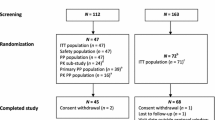Summary
The short-term bronchodilator effects of dry salbutamol powder and a pressurized salbutamol aerosol were compared in 22 patients with severe asthma, on 3 consecutive mornings, in a double-dummy cross-over study. Only patients with peak expiratory flow (PEF) rate lower than 250 l/min, were recruited. PEF measurement was employed to assess changes in ventilatory function induced by inhalation of the drugs. No significant difference was found between the PEF changes induced by the dry salbutamol powder (400 µg) and the pressurized aerosol (200 µg). Both forms of the drug produced a significant rise in mean PEF values. The study shows that even in asthmatic patients with poor ventilation, a dry powder inhaler and pressurized aerosol are effective means of drug delivery to the lungs.
Similar content being viewed by others
References
Editorial (1975) Fluorocarbon aerosol propellants. Lancet 1: 1073–1074
Hetzel MR, Clark TJH (1977) Comparison of salbutamol Rotahaler with conventional pressurized aerosol. Clin Allergy 7: 563–568
Hartley JPR, Nogrady SG, Gibby OM, Seaton A (1977) Bronchodilator effects of dry salbutamol powder administered by Rotahaler. Br J Clin Pharmacol 4: 673–675
Hartley JPR, Nogrady SG, Seaton A (1979) Long-term comparison of salbutamol aerosol in asthmatic out-patients. Br J Dis Chest 73: 271–276
Duncan D, Paterson C, Harris D, Crompton GK (1977) Comparison of the bronchodilator effects of salbutamol inhaled as a dry powder and by conventional pressurised aerosol. Br J Clin Pharmacol 4: 669–671
Svedmyr N, Löfdahl CG, Svedmyr K (1982) The effect of powder aerosol compared to pressurized aerosol. Eur J Respir Dis 63 [Suppl 119]: 81–88
Hallworth GW (1977) An improved design of powder inhaler. Br J Clin Pharmacol 4: 689–690
Anderson PB, Goude A, Peake MD (1982) Comparison of salbutamol given by intermittent positive-pressure breathing and pressure-packed aerosol in chronic asthma. Thorax 37: 612–616
Author information
Authors and Affiliations
Rights and permissions
About this article
Cite this article
Tukiainen, H., Terho, E.O. Comparison of inhaled salbutamol powder and aerosol in asthmatic patients with low peak expiratory flow level. Eur J Clin Pharmacol 27, 645–647 (1985). https://doi.org/10.1007/BF00547042
Received:
Accepted:
Issue Date:
DOI: https://doi.org/10.1007/BF00547042




